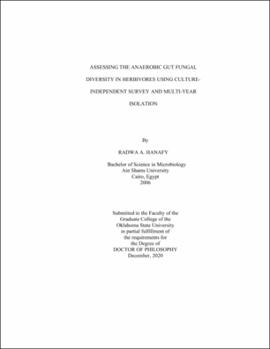| dc.contributor.advisor | Youssef, Noha | |
| dc.contributor.author | Hanafy, Radwa A. | |
| dc.date.accessioned | 2021-05-25T20:32:05Z | |
| dc.date.available | 2021-05-25T20:32:05Z | |
| dc.date.issued | 2020-12 | |
| dc.identifier.uri | https://hdl.handle.net/11244/329912 | |
| dc.description.abstract | The overall aim of my dissertation was to investigate the phylogenetic diversity, ecological distribution, and community structure of the anaerobic gut fungi (Neocallimastigomycota) in a wide range of herbivorous animals with special emphasis on hitherto unsampled herbivores. To achieve this aim, two approaches were employed in parallel, anaerobic culturing approaches as well as a culture-independent diversity survey. I conducted a multi-year isolation effort utilizing different isolation techniques, which maximized the recovery of multiple AGF isolates. My strategy involved the utilization of multiple carbon sources for AGF enrichment, sequence-guided strategy to target samples enriched in uncultured taxa, and sampling from a wide range of wild, domesticated, and zoo-housed herbivorous animals. This effort has resulted in the characterization of 10 novel AGF genera including five multiple previously uncultured AGF members. This resulted in more than doubling of the number of AGF genera with a cultured representative. This extensive culturing-based study was complemented with a culture-independent survey to evaluate AGF diversity in 27 herbivorous animals. The culture-independent survey also served to evaluate the utility of the D1/D2 region of the LSU rRNA as a new phylomarker for the AGF. The analysis produced the first comprehensive reference D1/D2 LSU database encompassing all cultured AGF genera, as well as the majority of candidate genera previously only identified in prior ITS1-based culture-independent surveys. Using the created database, I was able to identify a highly diverse anaerobic fungal community within the sampled animals, with twenty-eight genera and candidate genera, including multiple novel lineages. This work has established a framework for future utilization of D1/D2 LSU amplification and PacBio sequencing for AGF community assessment, and highlight the value of wild herbivores as untapped reservoirs for many yet-uncultured AGF taxa. Collectively, the results from this dissertation show that the genus-level diversity within Neocallimastigomycota is significantly broader than what was previously proposed, and argue that a large number of the yet-uncultured AGF genera are indeed culturable, given the right sampling and isolation conditions. | |
| dc.format | application/pdf | |
| dc.language | en_US | |
| dc.rights | Copyright is held by the author who has granted the Oklahoma State University Library the non-exclusive right to share this material in its institutional repository. Contact Digital Library Services at lib-dls@okstate.edu or 405-744-9161 for the permission policy on the use, reproduction or distribution of this material. | |
| dc.title | Assessing the anaerobic gut fungal diversity in herbivores using culture-independent survey and multi-year isolation | |
| dc.contributor.committeeMember | Elshahed, Mostafa | |
| dc.contributor.committeeMember | Patrauchan, Marianna A. | |
| dc.contributor.committeeMember | Hoff, Wouter | |
| dc.contributor.committeeMember | Marek, Stephen | |
| osu.filename | Hanafy_okstate_0664D_16929.pdf | |
| osu.accesstype | Open Access | |
| dc.type.genre | Dissertation | |
| dc.type.material | Text | |
| dc.subject.keywords | diversity | |
| dc.subject.keywords | gut fungi | |
| dc.subject.keywords | herbivores | |
| dc.subject.keywords | neocallimastigomycota | |
| thesis.degree.discipline | Microbiology, Cell and Molecular Biology | |
| thesis.degree.grantor | Oklahoma State University | |
